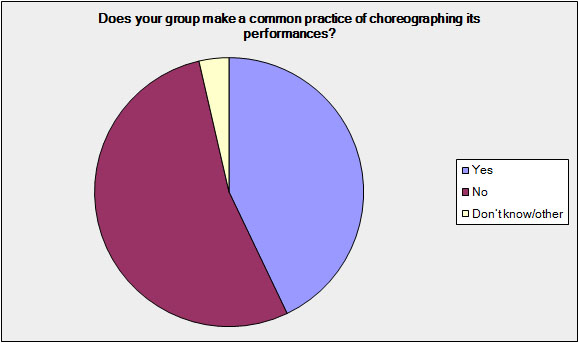Are Collegiate A Cappella Groups Choreographing?
In the fall of 2010, The A Cappella Blog invited every collegiate a cappella group we could find to participate in a survey. Our objective was to develop a better understanding of current trends in a cappella—what groups are or are not doing and to what degree.
Over 300 groups from across the US and abroad responded to the survey. Throughout our 2010 publication season, we will review results from this survey and talk about what our findings mean. We welcome and encourage groups to look over the information to learn, to benchmark and to satisfy their own curiosity.
This edition’s question: Does your group make a common practice of choreographing its performances?

Of the groups surveyed, over 53 percent indicated that they do not regularly choreograph their performances. As more and more groups seem to go all out in terms of visual presentation for the ICCAs, this is a bit of surprising figure.
Of course, the survey showed earlier, well under half of the responding groups are regularly competing in the ICCAs. When visual presentation isn’t a part of your scoring card, and instead you’re just doing your best to execute music and entertain your audience, it makes some sense that a substantial number of groups would opt not to spend a lot of time on learning dance moves to go with their music. Indeed, many purists would concur with the emphasis on sound over style, and even those of who enjoy a good visual show would generally agree that the music should take precedence.

With that being said, there was a remaining 43 percent of groups that did report that they made choreography a common practice. Competitive a cappella surely has an influence on this, but I would guess that these groups are equally if not more influenced by YouTube and the general culture of a cappella media getting shared beyond the confines of a group’s home school. Indeed, when a group sees other groups implementing slide motion choreography and stomp routines, they’ll be all the more inclined to get creative (or derivative) with their own motion. Furthermore, if they want to get noticed themselves, and create next viral video, they’ll be likely to throw in the moves to get themselves noticed.